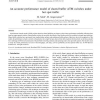Free Online Productivity Tools
i2Speak
i2Symbol
i2OCR
iTex2Img
iWeb2Print
iWeb2Shot
i2Type
iPdf2Split
iPdf2Merge
i2Bopomofo
i2Arabic
i2Style
i2Image
i2PDF
iLatex2Rtf
Sci2ools
COMCOM
1999
1999
An accurate performance model of shared buffer ATM switches under hot spot traffic
Asynchronous transfer mode (ATM) switches based on shared buffering are known to have better performance and buffer utilization than input or output queued switches. Shared buffer switches do not suffer from head of line blocking which is a problem in simple input buffering. Shared buffer switches have previously been studied under uniform and unbalanced traffic patterns. However, due to the complexity of the model, the performance of such a switch, in the presence of a single hot spot, has not been fully explored. In this article, we develop a model for a multistage ATM switch constructed of shared buffer switching elements and operating under a hot spot traffic pattern. The model is used to study the switch performance in terms of the throughput, cell delay, cell loss probability and the optimal buffer size. 1999 Elsevier Science B.V. All rights reserved.
| Added | 22 Dec 2010 |
| Updated | 22 Dec 2010 |
| Type | Journal |
| Year | 1999 |
| Where | COMCOM |
| Authors | Mahmoud Saleh, Mohammed Atiquzzaman |
Comments (0)

